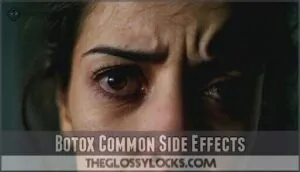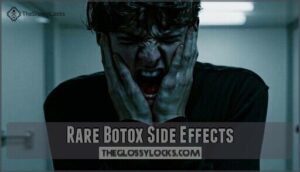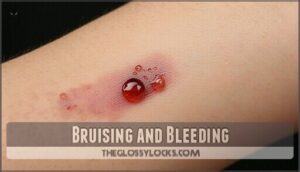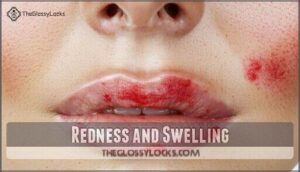This site is supported by our readers. We may earn a commission, at no cost to you, if you purchase through links.

Common side effects include minor headaches, redness, or tenderness at the injection site, and, occasionally, a droopy eyelid—like when your favorite coffee lid just won’t stay on.
Rarely, you might experience muscle weakness, trouble swallowing, or even breathing difficulties, especially if Botox spreads to unintended areas.
Allergic reactions, while uncommon, can happen too, and most side effects fade within days.
If something feels off, don’t hesitate to call your doctor, and if you are curious about ways to manage or prevent these risks, there’s more to learn about staying safe and confident.
Table Of Contents
- Key Takeaways
- Botox Common Side Effects
- Rare Botox Side Effects
- Botox Injection Site Reactions
- Botox Systemic Side Effects
- Botox Long Term Effects
- Managing Botox Side Effects
- Frequently Asked Questions (FAQs)
- What are Botox side effects?
- What are the typical side effects of Botox?
- Does Botox cause constipation?
- Can Botox cause drooping eyelids?
- What are the negative effects of Botox?
- What happens after 20 years of Botox?
- Can Botox make you unwell?
- What is the best alternative to Botox?
- What are the negatives to having Botox?
- Is Botox harmful over time?
- Conclusion
Key Takeaways
- You might experience mild side effects like headaches, redness, bruising, or droopy eyelids, but they typically fade within days.
- Serious issues like trouble breathing or swallowing are rare but require immediate medical attention if they happen.
- Following your provider’s post-injection care instructions can help manage and prevent most side effects effectively.
- Always choose a licensed professional to reduce risks and ensure safe Botox treatments.
Botox Common Side Effects
When you get Botox, it’s normal to experience some mild and temporary side effects.
Common issues like headaches, redness, or droopy eyelids usually fade within a few days and are rarely cause for concern.
Headaches and Migraines
Botox can ease chronic headaches and migraines by reducing muscle tension, but it’s not all relief and smiles.
Botox relieves migraines by relaxing muscles, but don’t let unexpected headache flare-ups overshadow the brighter days ahead.
A botox headache might crop up after treatment, though it’s usually mild and temporary.
If migraine frequency decreases but headache severity occurs post-injection, discuss this botulinum toxin side effect with your doctor.
Treatment efficacy varies, so monitor pain relief closely.
Injection Site Reactions
When getting botulinum toxin injections, minor injection site reactions aren’t unusual.
Here’s what to watch for:
- Bruising Prevention: Ice helps minimize marks quickly.
- Swelling Reduction: Elevate treated areas if they puff up.
- Redness Duration: It typically fades within a day or two.
- Itch Management: Over-the-counter creams soothe irritation.
These botox side effects are common and easy to manage.
Pain and Irritation
You might feel some injection site pain after a Botox treatment, like a pinch that lingers longer than expected.
Botox swelling and bruising are common but usually mild, fading within days.
Using lidocaine cream can minimize discomfort.
Chronic pain or nerve damage is rare, but sensory changes near treated areas are possible, so keep your provider informed.
Droopy Eyelids
A drooping eyelid, or ptosis, is a common Botox side effect caused by accidental botulinum toxin migration.
Severity factors include dosage and injection placement.
While botox eyelid droop is temporary, recovery timelines vary—often resolving within weeks.
Corrective options, like eye drops, can help, and for persistent ptosis, consult an ophthalmologist, as its psychological impact might affect confidence or daily routines.
Flu-Like Symptoms
Flu-like symptoms can make you feel sluggish after Botox, but they’re temporary.
Common botox side effects include:
- Mild fever and chills lasting a few days (Symptom Duration).
- Body aches or fatigue (Symptom Severity).
- Rest strategies, like naps, speed recovery.
- Stay hydrated—water’s your best friend (Hydration Importance).
- Focus on Flu Prevention by washing hands often.
If symptoms worsen, consult your doctor, and remember to stay hydrated and practice good hygiene.
Rare Botox Side Effects
You mightn’t expect Botox to cause serious complications, but rare side effects can happen and are worth knowing.
These include difficulty swallowing, trouble breathing, muscle weakness, vision problems, and even allergic reactions.
Difficulty Swallowing
Difficulty swallowing, or dysphagia, is a rare but serious side effect of Botox, often linked to botulinum toxin risks.
It disrupts swallowing mechanisms when Botox spreads to throat muscles. For those with pre-existing neuromuscular disorders or higher Botox dosages, the risk increases.
Severe cases, like aspiration pneumonia, may need hospitalization. Symptoms usually resolve within weeks.
| Symptom | Cause | Duration | Intervention Needed |
|---|---|---|---|
| Coughing/Choking | Dysphagia Causes | 7-14 days | Tube feeding in severe cases |
| Difficulty Swallowing | Neuromuscular Disorders | Temporary | Hydration aids |
| Thin Liquid Trouble | Swallowing Mechanisms | Variable | Hospitalization possible |
| Aspiration Pneumonia | Botox Dosage/Spread | Weeks | Medical care essential |
Trouble Breathing
Breathing difficulties, although rare, can occur after Botox, especially in those with pre-existing issues.
Botox-induced dyspnea may strike hours or weeks later, signaling muscle weakness or even respiratory paralysis.
Watch out for signs like labored breathing, as respiratory failure and aspiration risk are serious concerns.
Seek emergency treatment if symptoms appear, as untreated respiratory depression could lead to pneumonia risk—or worse.
Vision Problems
Vision problems, like blurred or double vision, can occasionally develop after Botox injections.
These effects often result from muscle relaxation near the eyes, sometimes leading to dry eyes or even ptosis (droopy eyelids).
In rare cases, corneal ulceration may occur if blinking is reduced. If you notice irritation, dryness, or persistent issues, consult your doctor promptly to avoid complications.
Muscle Weakness
Muscle weakness from Botox, though uncommon, can affect daily activities, particularly in those with neuromuscular disorders.
When botulinum toxin spreads beyond the injection site, it may lead to exaggerated weakness or Long-Term Atrophy.
This risk increases with unapproved uses or excessive doses. If muscle contractions feel weaker than expected, consult your doctor promptly to address potential Botox side effects.
Allergic Reactions
Allergic reactions to Botox are rare but important to watch for. Symptoms include rash and hives, swelling symptoms, or even an anaphylaxis risk, which requires immediate help.
Some may experience delayed reactions, so stay alert for changes days later. Cross-reactivity to ingredients could also happen.
Those with sensitive skin may experience skin and scalp irritation, similar to reactions from certain hair masks. If you notice any botox allergy symptoms, consulting your provider is key.
Botox Injection Site Reactions
When you get a Botox injection, it’s completely normal to notice mild effects like redness, swelling, or bruising around the injection site.
These reactions are usually temporary and can be managed with simple care, so there’s no need to panic, as they are typically mild.
Bruising and Bleeding
Botox injection side effects like bruising and bleeding can be pretty common, especially if you’re on blood thinners or have underlying conditions.
Bruising severity varies, but prevention methods—like avoiding alcohol and certain medications pre-appointment—help.
Post-treatment care includes icing the area to reduce botox bruising. For managing these issues, consider exploring options for botox bruising treatment.
Bleeding risks are minimal but make certain your provider knows your medical history to avoid botox complications.
Redness and Swelling
After a Botox injection, redness and swelling at the injection site are common and usually resolve quickly.
Swelling causes vary but often include natural inflammation, and post-procedure care, like applying a cold compress, can offer redness relief.
While these botox side effects are mild, watch for allergic redness or prolonged swelling, as these may indicate potential botox complications or adverse reactions.
Itching and Irritation
Sometimes, you might notice itching skin or redness near the injection site.
This could result from a mild histamine response or skin sensitivity.
Though rare, pruritus or allergic dermatitis may indicate an allergic reaction.
Nerve involvement and minor skin rash can also occur, but they’re temporary.
Avoid scratching to prevent irritation—your skin’s just saying, "Adjusting to Botox here!
Pain Management
Feeling tender after an injection isn’t uncommon.
To ease botox injection pain, try using lidocaine cream or an ice pack for quick relief.
For stubborn discomfort, Post-Botox Analgesics like ibuprofen can help.
Simple steps like avoiding rubbing can substantially improve how you experience botox side effects.
To further soothe irritation, consider calming serums application.
Managing nerve pain or chronic pain relief might require guidance from your doctor.
Botox Systemic Side Effects
When Botox enters your system, it can occasionally cause effects beyond the injection site, such as nausea, fatigue, or fever.
While these systemic side effects are rare, they’re important to recognize and manage effectively.
Nausea and Vomiting
Nausea and vomiting, though uncommon, can occur as Botox side effects, often part of gastrointestinal adverse events.
These symptoms may have a delayed onset, influenced by severity factors like dosage or medication interactions.
Dehydration risks heighten if vomiting persists, so staying hydrated helps, consider alternative relief like ginger tea or consult a doctor to rule out serious Botox adverse reactions.
Fever and Chills
Occasionally, Botox side effects include fever and chills, usually signaling a mild immune response.
While these symptoms are temporary, here’s what to watch for:
- Fever Duration: Typically lasts 1–3 days.
- Chills Severity: Slight shivers to moderate discomfort.
- Body Temperature: Check for spikes over 100.4°F.
- Symptom Management: Rest, fluids, and OTC meds.
- When to Worry: Persistent symptoms need a doctor’s input.
Allergic reactions, such as skin irritation, can occur with some treatments.
Body Aches and Fatigue
Experiencing body aches or pain, including muscle soreness and joint discomfort, is one of Botox’s potential side effects.
This post-Botox malaise might leave you feeling sluggish, resembling mild energy depletion or chronic fatigue.
These aches typically fade quickly, but staying hydrated and stretching gently can help.
If fatigue or muscle aches persist, consult your provider for reassurance and guidance.
Headache and Facial Pain
Botox-induced headaches and chronic facial pain might catch you off guard, often linked to post-Botox symptoms like muscle weakness or tension.
Pain severity factors vary, but alternative pain relief options—like over-the-counter meds or ice packs—can help.
If the headache lingers or worsens, consult your doctor. Remember, these Botox side effects are typically temporary and manageable with the right care.
Botox Long Term Effects
When you think about Botox’s long-term effects, it’s important to know they aren’t all about smooth skin and fewer wrinkles.
Over time, repeated treatments may lead to issues like facial muscle weakness or subtle changes in movement, which can be a significant consideration for those using Botox.
Facial Weakness and Drooping
Facial paralysis after Botox can affect your smile and natural expressions.
Common issues include drooping eyelids (ptosis), mouth drooping, and expression changes caused by Botox muscle weakness.
In rare cases, patients may experience difficulty with swallowing, especially after neck injections.
To avoid these, follow these tips:
- Avoid rubbing injection areas.
- Choose licensed providers for precision.
- Report asymmetry or weakness early.
- Monitor for lasting asymmetry or eyelid ptosis.
Muscle Atrophy and Weakness
Muscle weakness and muscle fiber loss from Botox occur due to nerve signal blockage that prevents muscle contractions, leading to muscle relaxation.
Over time, this can result in muscle wasting or even long-term paralysis in rare cases.
While compensatory mechanisms may kick in, rehabilitation strategies help restore strength once treatments stop, proving most effects are reversible with proper care.
Similarly, some hair treatments may cause increased hair breakage, which can be a significant concern for those undergoing such treatments, highlighting the need for proper care.
Vision Problems and Dry Eyes
Blurred vision or double vision might leave you feeling like you’re seeing double trouble after Botox. These side effects can also include corneal ulceration or nagging eye irritation.
Watch for:
- Persistent light sensitivity causing discomfort.
- Dry eyes that lubricating drops can’t fix.
- Eye twitching lasting longer than usual.
- Fluctuating vision affecting daily tasks.
Always report vision problems promptly to your doctor, as persistent issues can lead to serious complications, and it’s crucial to address them with proper medical attention.
Breathing and Swallowing Difficulties
Swallowing difficulties (dysphagia) and trouble breathing are rare but serious side effects tied to improper Botox dosage or poor injection technique.
Issues like aspiration pneumonia may occur, especially in those with neuromuscular disorders.
| Symptom | Cause | Risk Factors |
|---|---|---|
| Difficulty swallowing | Spread of toxin | Neuromuscular disorders |
| Trouble breathing | Muscle paralysis | Incorrect injection sites |
| Aspiration pneumonia | Weak swallowing muscles | High-risk patients |
Always use licensed providers to avoid counterfeit Botox risks.
Managing Botox Side Effects
If Botox side effects catch you off guard, don’t worry—they’re usually manageable with the right care.
From seeking medical advice to simple at-home remedies, you’ve got options to ease discomfort and stay safe.
Seeking Medical Attention
If you notice urgent symptoms, like worsening swelling, breathing issues, or vision trouble, call a licensed healthcare provider immediately.
Infection signs or allergic reactions shouldn’t be ignored—think redness or rashes beyond the injection site.
Serious side effects like botulism risks deserve fast action, and it is crucial to trust your instincts and seek medical attention promptly for botox side effect treatment before complications escalate.
Treatment and Prevention
To manage Botox side effects, apply ice packs to bruises and discuss alternative toxins or dermal fillers with your provider.
It’s essential to monitor progress and consult licensed professionals for safe treatments.
Address discomfort with over-the-counter pain relief while staying alert for unusual reactions.
Some patients seek solutions for bruising knowing botox injection risks helps you stay prepared and guarantees effective botox side effect treatment.
Alternative Therapies and Remedies
If Botox isn’t your thing, try alternative treatments like Dermal Fillers or Xeomin/Dysport, which offer similar benefits.
Topical treatments, like anti-aging serums, work wonders for smooth skin too.
Lifestyle changes and natural remedies, like diet and acupuncture, support skin health.
Dermal fillers provide an alternative for facial rejuvenation.
For post-injection relief, manage irritation with ice packs or lubricating eye drops—your friendly ophthalmologist can guide you!
Follow-Up Care and Monitoring
How do you stay on top of your Botox journey? Follow-up care is key to maintaining long-term efficacy and guaranteeing your psychological wellbeing.
Make injection follow-up appointments to monitor progress, discuss dosage adjustments with your health care provider, and ask about preventative measures for side effects.
Proper post-procedure care, like avoiding strenuous activities, guarantees smooth results and prompt recovery.
Frequently Asked Questions (FAQs)
What are Botox side effects?
Think of it as a double-edged sword—Botox can smooth wrinkles but may cause mild pain, bruising, or droopy eyelids.
Rarely, it triggers difficulty swallowing or breathing.
Always choose licensed professionals for safe treatments.
What are the typical side effects of Botox?
You might feel some mild pain, swelling, or bruising at the injection site, plus possible headaches or flu-like symptoms.
Rarely, temporary facial drooping or dry eyes could occur, so follow post-care instructions closely.
Does Botox cause constipation?
Surprisingly, constipation isn’t a typical Botox side effect, but it can pop up occasionally, especially with treatments for health conditions like overactive bladder.
If you notice it, hydrate, eat fiber, and consult your provider.
Can Botox cause drooping eyelids?
Yes, Botox can cause drooping eyelids, known as ptosis.
It happens when the injected toxin spreads to nearby muscles.
Although rare, it’s a temporary side effect that typically resolves within weeks.
What are the negative effects of Botox?
Botox can cause mild side effects like redness, swelling, or headaches.
Rarely, it leads to drooping eyelids, muscle weakness, or vision issues.
Severe cases might include breathing troubles or swallowing difficulties—ensure a licensed pro administers it to avoid such severe complications.
What happens after 20 years of Botox?
After 20 years, you’ll notice smoother skin but also reduced muscle strength in treated areas.
It won’t stop natural aging, so untreated wrinkles persist, but proper care and professional guidance can balance the effects beautifully.
Can Botox make you unwell?
Feeling unwell after Botox is rare but possible.
Side effects like flu-like symptoms, headaches, or mild nausea might occur.
Don’t panic; they’re usually temporary.
Talk to your provider if symptoms linger or worsen.
What is the best alternative to Botox?
Dermal fillers, like Juvederm or Restylane, are great options if you’d rather skip Botox.
They can restore volume, smooth wrinkles, and last longer.
Plus, they don’t freeze muscles, so expressions stay natural.
What are the negatives to having Botox?
Imagine your face feeling frozen mid-laugh—Botox can cause droopy eyelids, bruising, headaches, or even flu-like symptoms.
Rarely, it might weaken muscles or affect swallowing and breathing.
Always consult a skilled professional beforehand!
Is Botox harmful over time?
Botox isn’t inherently harmful long-term when used properly.
But repeated use may cause weakened muscles or resistance over time.
Stick with licensed providers, follow guidelines, and communicate concerns to reduce risks and guarantee safety.
Conclusion
Managing the side effects of Botox is like steering a ship—you need the facts to stay on course.
While most reactions, like minor headaches or injection site redness, are temporary, rarer issues like muscle weakness or breathing trouble require prompt attention.
Understanding risks helps you make informed choices and manage complications effectively.
If something feels off, don’t hesitate to reach out to your doctor, and with careful monitoring, you can stay confident while enjoying Botox’s potential benefits.
- https://www.ncbi.nlm.nih.gov/pmc/articles/PMC6409137/
- https://www.rxabbvie.com/pdf/botox_pi.pdf
- https://www.accessdata.fda.gov/scripts/medwatch/index.cfm
- http://healthline.com/health/skin-blushing-flushing
- https://www.nhs.uk/conditions/cosmetic-procedures/non-surgical-cosmetic-procedures/botox-injections/















